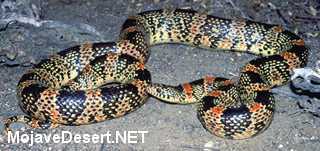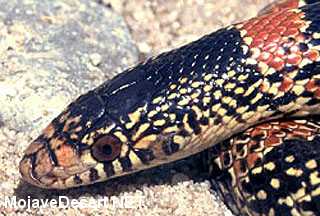Long-nosed Snake
Rhinocheilus leconteiFamily: Colubridae Order: Squamata Class: Reptilia
DISTRIBUTION, ABUNDANCE, AND SEASONALITY
Common only in desert regions and locally in coastal southern California, the long-nosed
snake is uncommon in the interior Coast Ranges and the adjacent floor of the Central Valley
from Sutter and Butte cos. south. This species ranges widely in southern California and is
known from desert regions east of the Sierra and Cascade Ranges north to the Oregon
border. A snake primarily of grasslands, arid brushlands, and coastal chaparral, the
long-nosed snake is not expected in forested types. Elevation sea level to 1620 m (5400 ft).
SPECIFIC HABITAT REQUIREMENTS
Feeding: Long-nosed snakes prey heavily on lizards but also take rodents and other small
prey. Stebbins (1954) listed mammals, lizards and lizard eggs, and insects as among the
food items taken. Captive individuals have also eaten small snakes.
Cover: Seldom found under surface objects, long-nosed snakes are good burrowers.
Nussbaum et al. (1983) report that disturbed individuals burrow rapidly into loose soil, and
that they often lie covered with sand with only their head exposed. They may also seek cover
in rock crevices (Stebbins 1954).
Reproduction: Little is known about habitat requirements for reproduction in this species.
Females are thought to deposit egg clutches in loose, moist, well-aerated soil. Abandoned
mammal burrows may also be utilized as nest sites.
Water: No information on water requirements. This is a snake of arid lands, seldom
encountered near stream courses. Standing water is not an important habitat element.
Pattern: Inhabits deserts, plains and brushland, seldom found near water.
SPECIES LIFE HISTORY
Activity Patterns: Nocturnal and crepuscular, occasional diurnal activity has been
reported. Individuals are most commonly encountered from April thru June (Klauber 1941). A
period of winter inactivity occurs at all localities.
Seasonal Movements/Migration: Predictable seasonal movements have not been reported
for this species in California.
Home Range: The nature of the home range in this species is unknown.
Territory: No evidence for the territorial defense of resources has been reported.
Reproduction: Five to 8 eggs are deposited in July. Hatchlings emerge in late August or
September.
Niche: Long-nosed snakes appear in the diet of hawks (Nussbaum et al. 1983), and they
are taken as prey by other snakes (Cunningham 1959). Competitive interactions between
this somewhat fossorial species and other snakes (some of them also good burrowers) with
which they co-occur are largely unknown.
Also see:
Joshua Tree National Park Wildlife
Western Long-nosed Snake Rhinocheilus lecontei lecontei Creosote bush scrub and pinyon-juniper woodlands (common) Desert Patch-nosed Snake ...
Death Valley Snakes
Western Long-nosed Snake Rhinocheilus lecontei lecontei Nocturnal; mid-elevations of park Western Ground Snake Sonora semiannulata ...
REFERENCES
Cunningham, J. D. 1959. Reproduction and food of some California snakes. Herpetologica 15:17-19.
Diller, L. V., and R. C. Wallace. 1981. Additional distribution records and abundance of three species of snakes in souwestern Idaho. Great Basin Nat. 41:154-157.
Klauber, L. M. 1941. The long-nosed snakes of the genus Rhinocheilus. Trans. San Diego Soc. Nat. Hist. 9:289-332.
Medica, P. A. 1975. Rhinocheilus, R. lecontei. Cat. Am. Amphibians and Reptiles. 175.1- 174.4.
Nussbaum, R. A., E. D. Brodie, Jr., and R. M. Storm. 1983. Amphibians and reptiles of the Pacific Northwest. Univ. Press of Idaho. 332pp.
Stebbins, R. C. 1954. Amphibians and reptiles of western North America. McGraw-Hill, New York. 536pp.
EXTERNAL LINKS
Reptiles of Arizona
Long-nosed Snake - Rhinocheilus lecontei Maricopa County, AZ. Long-nosed Snake - Rhinocheilus ...
Rhinocheilus lecontei lecontei - Western Long-nosed Snake
Rhinocheilus lecontei lecontei - Western Long-nosed Snake ... Genus, Rhinocheilus, Long-nosed Snakes. Species, lecontei, Long-nosed Snake. Subspecies ...
wildherps.com - Long-nosed Snake (Rhinocheilus lecontei)
Western Long-nosed Snake (Rhinocheilus lecontei lecontei). We saw three of these attractive snakes by flashlight at night, two adults and one juvenile. ...
Rhinocheilus lecontei
The Long-nosed Snake (Rhinocheilus lecontei) is a species of non-venomous colubrid snake. It is the only species in the genus Rhinocheilus, ...
Rhinocheilus lecontei, the Long-Nosed Snake
Rhinocheilus lecontei - Western Long-Nosed Snake Photos by Chris Brown. Scientific name: Rhinocheilus lecontei. Rhinocheilus lecontei - Western Long-Nosed ...
Reptiles: Longnose snake (Rhinocheilus) bibliography
A New Long-nosed Snake (Rhinocheilus lecontei) from Isla Cerralvo, Baja California Sur ... Range extension of the long-nosed snake Rhinocheilus l. lecontei, ...
Rhinocheilus lecontei tesselatus - Texas Long-nosed Snake
Rhinocheilus lecontei tesselatus - Texas Long-nosed Snake. Click on a picture for a larger view. Adult, Terrell County, Texas. Adult, Terrell County, Texas ...
Long-nosed Snake
Rhinocheilus lecontei. rule. thumbnail. Context. Kingdom: Animalia Phylum: Chordata Class: Reptilia Order: Squamata Suborder: Serpentes ...
Long Nosed Snake
Long Nosed Snake (Long Nosed Snake) Rhinocheilus lecontei ... The long nosed snakes of the genus Rhinocheilus. Trans. San Diego Soc. Nat. Hist. 9:289-332. ...
The Tucson Herpetological Society
Western Long-nosed Snake Rhinocheilus lecontei lecontei. photo by Robert L. Bezy and Kathryn Bolles. Western Long-nosed Snake Rhinocheilus lecontei lecontei ...

Long-nosed Snake
Photo by Chris Brown

Long-nosed Snake
Photo by Chris Brown
Additional information:
Scientific name: Rhinocheilus lecontei
Common name: Western Long-Nosed Snake
Size: 18.9-29.5 in (48-75 cm)
Distinguishing characters: A slender species; cream ground color; black dorsal saddles with red interspaces; cream or yellow venter; black spotting on a white head; black saddles speckled with white on the sides; very pointed snout; countersunk lower jaw; anterior portion of subcaudal scales undivided in most individuals.
Juveniles: Banding more pronounced; speckling on sides faint or absent.
Dimorphism: None
Similar species: Lampropeltis getula: Have banding completely around body; all subcaudals divided; rounded snouts; lack countersunk lower jaw.
Additional notes: A gentle species that vibrates tail when annoyed. Some individuals may hemorrhage from the cloaca and excrete musk when handled.